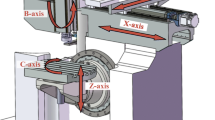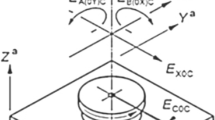Abstract
S-shaped test piece aims to assess the performance of five-axis numerical control (NC) machine tools. When the draft international standard (DIS) was introduced at the 79th ISO/TC39SC2 meeting, it was agreed that this test piece would be included. The S-shaped test piece, however, has undeveloped surfaces, which contribute to theoretical error. Because the test piece is used to assess the performance of machine tools and to conduct error tracing, theoretical error should not be included in the detection results obtained by the coordinate measuring machine (CMM). Therefore, the S-shaped test piece, excluding the influences of theoretical error, is crucial to research. This paper calculates the theoretical error of the S-shaped test piece when processed with the single-point offset (SPO) position method and proposes pre-compensation (PRC) and post-compensation (POC) methods to eliminate the influences of theoretical error. We conducted a theoretical analysis to compare three methods, the two compensation methods and the one uncompensated method, and verified the results through actual experiments. Research from principle and practice demonstrates that both the PRC and POC methods compensated for theoretical error up to 0.01 mm and that PRC is more accurate when considering the difference of approximately ±0.0015 mm.
Similar content being viewed by others
References
Jha BK, Kumar A (2003) Analysis of geometric errors associated with five-axis machining centre in improving the quality of cam profile. Int J Mach Tool Manu 43(6):629–636. doi:10.1016/S0890-6955(02)00268-7
Soichi I, Goh S, Kunitaka T (2014) ‘Open-loop’ tracking interferometer for machine tool volumetric error measurement—two-dimensional case. Precis Eng 38(3):666–672. doi:10.1016/j.precisioneng.2014.03.004
Xiang S, Yang J, Zhang Y (2014) Using a double ball bar to identify position-independent geometric errors on the rotary axes of five-axis machine tools. Int J Adv Manuf Technol 70(9):2071–2082. doi:10.1007/s00170-013-5432-9
Hong C, Ibaraki S, Oyama C (2012) Graphical presentation of error motions of rotary axes on a five-axis machine tool by static R-test with separating the influence of squareness errors of linear axes. Int J Mach Tool Manu 59(2):24–33. doi:10.1016/j.ijmachtools.2012.03.004
Matsushita T, Oki T, Matsubara A (2008) The accuracy of cone frustum machined by five-axis machine tool with tilting table. J Jpn Soc Precis Eng 74(6):632–636. doi:10.2493/jjspe.74.632
Weikert S (2004) R-test, a new device for accuracy measurements on five axis machine tools. CIRP Ann Manuf Technol 53(1):429–432. doi:10.1016/S0007-8506(07)60732-X
Mou WP, Song ZY, Guo ZP, Tang LM (2012) A machining test to reflect dynamic machining accuracy of five-axis machine tools. Adv Mater Res 622-623:414–419. doi:10.4028/www.scientific.net/AMR.622-623.414
Guan LW, Mo J, Fu M, Wang LP (2017) An improved positioning method for flank milling of s-shaped test piece. Int J Adv Manuf Technol:1–16. doi:10.1007/s00170-017-0180-x
Su Z, Wang L (2015) Latest development of a new standard for the testing of five-axis machine tools using an S-shaped test piece. Proc Inst Mech Eng B J Eng Manuf 229(7). doi:10.1177/0954405414560780
Wang W, Zhang XY, Mei X (2016) Research on the mechanism of free surface contour error caused by the stiffness of feed system of five-axis machine tools. J Mech Eng 52(21). doi:10.3901/JME.2016.21.146
Wang W, Jiang Z, Li Q, Tao W (2015) A new test part to identify performance of five-axis machine tool-part ii validation of s part. Int J Adv Manuf Technol 79(5):739–756. doi:10.1007/s00170-015-6869-9
Li DU, Zheng CZ, Bian ZY, Zhao XD, Wang W (2015) Research on reconstruction and optimization of the “S”shaped test piece. Modular Machine Tool & Automatic Manufacturing Technique. doi:10.13462/j.cnki.mmtamt.2015.04.002
Du L, Zhang X, Zhao S, Li J (2014) Research on five-axis cnc machining method of S shaped detection test piece. China Mech Eng 25(21):2907–2911. doi:10.3969/j.issn.1004-132X.2014.21.013
Du L, Zhang X, Wang W, Fu ZH, Shi RB (2014) Research on properties of “S” shaped test piece on synthesis dynamic accuracy detection of five-axis cnc machine tools. J Univ Electron Sci Technol China 43(4):629–635. doi:10.3969/j.issn.1001-0548.2014.04.028
Song Z, Cui Y (2010) S-shape detection test piece and a detection method for detecting the precision of the numerical control milling machine. US, US 20100004777 A1
Liang Q, Wang YZ, Hong Y, Zhen Y (2008) Cutting path planning for ruled surface impellers. Chin J Aeronaut 21(5):462–471. doi:10.1016/S1000-9361(08)60060-6
Chiou JCJ (2004) Accurate tool position for five-axis ruled surface machining by swept envelope approach. Comput Aided Des 36(10):967–974. doi:10.1016/j.cad.2003.10.001
Gong H, Cao LX, Liu J (2005) Improved positioning of cylindrical cutter for flank milling ruled surfaces. Comput Aided Des 37(12):1205–1213. doi:10.1016/j.cad.2004.11.006
Gong H, Fang FZ, Hu XT, Cao LX, Liu J (2010) Optimization of tool positions locally based on the bceltp for 5-axis machining of free-form surfaces. Comput Aided Des 42(6):558–570. doi:10.1016/j.cad.2010.02.006
Senatore J, Monies F, Redonnet JM, Rubio W (2007) Improved positioning for side milling of ruled surfaces: analysis of the rotation axis’s influence on machining error. Int J Mach Tool Manu 47(6):934–945. doi:10.1016/j.ijmachtools.2006.07.008
Marciniak K (1991) Geometric modelling for numerically controlled machining. Oxford University Press, Oxford
Redonnet JM, Rubio W, Dessein G (1998) Side milling of ruled surfaces: optimum positioning of the milling cutter and calculation of interference. Int J Adv Manuf Technol 14(7):459–465. doi:10.1007/BF01351391
Rubio DW, Lagarrigue P, Dessein G, Pastor F (1998) Calculation of tool paths for a torus mill on free-form surfaces on five-axis machines with detection and elimination of interference. Int J Adv Manuf Technol 14(1):13–20. doi:10.1007/BF01179412
Anderson C (1988) Curves and surfaces in computer aided geometric design, by F. Yamaguchi. Curves and surfaces in computer aided geometric design. Springer-Verlag
Castillo R, Mendoza E, Comia J (2015) On minimum distance problem. Am Sci Res J Eng Technol Sci 11(1):84–95
Author information
Authors and Affiliations
Corresponding author
Rights and permissions
About this article
Cite this article
Guan, L., Mo, J., Fu, M. et al. Theoretical error compensation when measuring an S-shaped test piece. Int J Adv Manuf Technol 93, 2975–2984 (2017). https://doi.org/10.1007/s00170-017-0715-1
Received:
Accepted:
Published:
Issue Date:
DOI: https://doi.org/10.1007/s00170-017-0715-1




